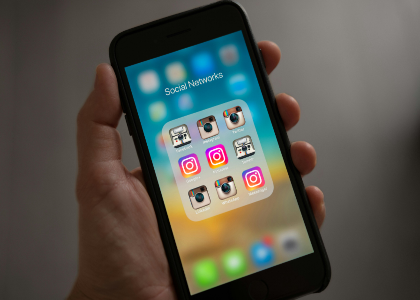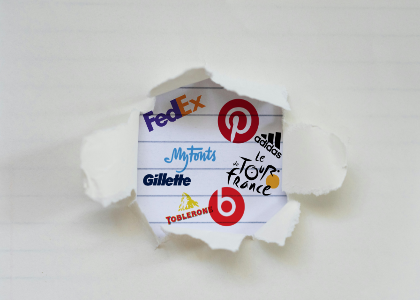Blog

How To Find The Right Brand Voice: A Simple 5-Step Guide
Have you ever felt an instant connection with a brand? Like the words they speak were tailored just for you?
That's the magic of a powerful brand voice. It can turn a simple message into an engaging conversation, transforming audiences into loyal brand ambassadors.
And as online competition continues to heat up, crafting a distinctive brand voice is a non-negotiable for success. In this article, we will discuss the art and the science behind crafting the right brand voice for your business.
Step 1: Understand Your Brand's Identity
Thinking about your brand's identity is like an introspective journey. It's about self-discovery. And it's about unveiling the unique essence of your brand.
First, consider your brand's core values. These are the principles that guide every action your brand takes. Like a lighthouse in the fog, they illuminate the path forward and offer direction during decision-making processes.
If Google's "Don't be evil" mantra rings a bell, it's because that phrase is a great example of a brand value that's not just memorable but also shapes the company's policies and strategies.
Next, clarify your brand's personality. This refers to the human characteristics attributed to your brand, which can shape the way people perceive and interact with it. For example, a technology company might personify itself as innovative and forward-thinking, while an organic food brand might go for a nurturing and down-to-earth vibe.
Remember, your brand's personality should mirror what your brand stands for and how you wish your audience to perceive it.
Dove, the personal care brand, has brilliantly defined itself as an empathetic, caring advocate for real beauty. This resonates with its audience's desire for inclusivity and self-acceptance. Plus, it differentiates Dove in the saturated beauty market.
So, spend some time peeling back the layers of your brand's identity. Understand its core values and shape its personality to align with those values. This exercise requires marketable skills and experience, but it will lay the foundation for your brand's voice.
Step 2: Know and Analyze Your Audience
The second step on this journey involves flipping the lens towards your audience. Because your brand's voice isn't just about you — it's also about the people you're trying to reach and resonate with.
Start by creating detailed audience personas, or semi-fictional representations of your ideal customers. Flesh out these personas with information like demographics, psychographics, preferences, and pain points. As you do this, you're not just building a database of audience traits, but you're humanizing your audience, making it easier to understand and connect with them.
For instance, if you're a tech start-up with a project management tool, one of your audience personas might be "Freelancer Fiona," an independent contractor juggling multiple client projects and looking for a solution to streamline her workflow. This persona will help you brainstorm how to communicate with the freelancers in your audience. And to bring these personas to life, you could always use an AI character generator to create visual representations.
As you create these personas, put yourself in your audience's shoes and ask: "What kind of voice would resonate with me?"
- Formal or casual?
- Witty or straightforward?
- Enthusiastic or calm?
- Playful or serious?
If you're targeting corporate professionals, a formal, informative voice might strike the right chord. On the other hand, if you're targeting young, environmentally conscious consumers, a voice that's passionate, inspiring, and slightly casual might be more fitting.
Look at the brand voice of Old Spice as inspiration. They've hit the bullseye when it comes to knowing their audience. With their hilarious, over-the-top advertisements, they appeal directly to their young, humor-appreciating demographic.
Step 3: Evaluate Your Competitors
It's helpful to perform a comprehensive review of your competition before finalizing your brand voice. This can highlight the industry standards for communication and uncovers opportunities to differentiate your brand. Competitive analysis isn't about copying or one-upping your competitors — it's about understanding the playing field and identifying gaps you can fill.
Begin by listing out your primary competitors, then examine their brand voices one by one. Examine the language they use, the tone they adopt, and how they engage with their audience. Again, ask yourself: Are they humorous or serious? Formal or informal? What are they doing right, and where are they falling short?
If you plan to enter the athletic apparel space, for example, you should take a close look at brands like Nike and Adidas. You will notice their inspiring, empowering voices. This might prompt you to adopt a similar voice, or perhaps you can carve out a niche with a more playful, light-hearted approach.
Learn from Patagonia. In the outdoor apparel industry, they have created a distinctive voice through their strong commitment to environmental activism. Their voice isn't just about selling products, but about making a difference. And this sets them apart from their competitors, especially in the eyes of eco-minded customers.
Step 4: Formulate Your Brand Voice
With a clear understanding of your brand's identity, audience, and competitive landscape, it's time to shape your brand voice. This is your opportunity to create something unique that reflects your brand's personality, resonates with your audience, and distinguishes you from the competition.
To start, define three to four descriptors for your brand voice. You might choose any combination of the following:
- Passionate, inspiring, and relatable
- Professional, authoritative, and respectful
- Dynamic, innovative, and engaging
- Fun, friendly, and adventurous
- Compassionate, trustworthy, and uplifting
Next, provide additional context for each descriptor.
What does "inspiring" look like in your communication? Perhaps it's sharing success stories, motivating quotes, or powerful imagery. How does "professional" translate into your brand's messaging? It could be using industry jargon, citing reputable sources, or maintaining a formal tone.
Consider the Mailchimp brand, a well-known email marketing platform, loved for its approachable, quirky, and slightly offbeat brand voice. Their communication is filled with wit, playful humor, and a conversational tone, which distinguishes them in the somewhat dry landscape of B2B technology.
Step 5: Continually Refine Your Brand Voice
Once you've formulated your brand voice, it's time to bring it to life across all your communication channels. Consistency is key here. Your voice should be recognizable whether a customer is reading a blog post, social media update, or product description.
To ensure consistency, create a brand voice guide. This document should outline your brand voice descriptors, provide examples, and offer guidelines on how to apply the voice across different platforms and content types.
Make this guide available to anyone who might be crafting content for your brand, from marketing teams to customer service reps. And even if you use AI writing tools, this guide can serve as the bedrock for crafting content that maintains your brand's distinctive tone.
But the work doesn't stop here. Continually refine your brand voice. Consumer preferences evolve, and so should your business. Gather feedback from your audience, monitor how your content performs, and adjust as necessary. Remember, your brand is a dynamic entity — not a static one.
Take Netflix as an example. Their brand voice has evolved alongside their platform, maintaining a casual, conversational tone that keeps up with current trends and audience preferences. The streaming platform is not afraid to use humor, cultural references, and a hint of sass. They continue to adjust their voice based on audience engagement.
The journey to finding the right brand voice is a strategic, introspective, and creative one. But, by following the steps outlined in this guide, you can create a powerful tool that connects with your audience, differentiates your brand, and propels your success.
More tips and tricks on the blog


